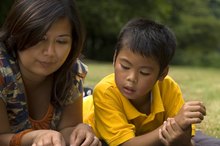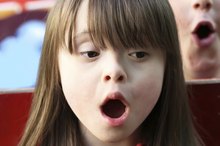How to Identify Potential Barriers in Learning in Children
Success in school is not easily attainable for all children and many experience barriers that make learning challenging. Kids may have difficulty understanding new concepts, an inability to focus long enough to learn the material being presented, or an undiagnosed disability. The ability to recognize potential barriers will enable you to work with your child's teacher to implement alternate instructional strategies so your child is able to learn.
Look at your child's homework and classwork. You can discover the areas that your child has difficulty with by analyzing what grades he receives and why, advises Rock Moore and Michelle A. Moore, authors of "Active Teaching and Learning Strategies: Creating a Blueprint for Success." Poor grades can highlight subjects or concepts your child does not understand so you can begin the process of discovering what barriers are preventing him from internalizing specific information 1.
Visual Perception Problems in Children
Learn More
Watch how your child uses his fine motor skills, which are the skills that allow your child to complete tasks such as writing legibly, cutting with scissors and gluing. These skills are essential components of success at school because they enable your child to complete a variety of school-related tasks designed to increase comprehension, according to Christine MacIntyre, author of "Identifying Additional Learning Needs: Listening to the Children." If your child struggles to form letters or complete hands-on tasks you should consider speaking with his teacher to learn ways to help him improve his fine motor skills 2.
Identify whether your child has a hard time sitting still and paying attention. MacIntyre writes that some children have a difficult time learning because they would rather be moving around doing things rather than sitting still and listening. Attention Deficit Hyperactivity Disorder (ADHD) is a diagnosis that often accompanies chronic restlessness and impulsive behavior. Even if your child does not have ADHD, speaking with your child's teacher about alternate ways to encourage concentration, such as turning his desk away from his peers, can help your child make improvements in learning.
Exercises for Children With Absent Mindedness
Learn More
Determine how much time your child spends actively engaging in subject material. Many children are visual learners and simply listening to a teacher talk does not allow them to grasp the material being presented. Moore, et al 1. write that children cannot learn without trying what they are being taught. Science experiments, art projects and role playing all play important parts in your child's ability to process what he is learning. Speak with your child's teacher to see how much time he is actively engaging and consider adding some active learning opportunities at home to supplement what is happening at school.
Have your child's eyesight and hearing checked. It is difficult for a child to learn if he cannot see or hear well. MacIntyre writes that disabilities often present learning barriers because they make academic achievement even more difficult. If your child cannot see well, glasses can help him make significant progress at school. Hearing problems can be addressed with hearing aids or different placement in the classroom.
Tips
Approach your child's teacher with any concerns you have. Her job is to educate your child and working together will enable her to do so.
Warnings
Do not ignore any problems you feel your child may have. If your child falls behind at school, future learning will be even more difficult for him.
Related Articles
References
- Active Teaching and Learning Strategies: Creating a Blueprint for Success; Rock Moore and Michelle A. Moore; 2004
- Identifying Additional Learning Needs: Listening to the Children"; Christine MacIntyre; 2005
- Bear JJ, Wu YW. Maternal infections during pregnancy and cerebral palsy in the child. Pediatr Neurol. 2016;57:74-79. doi:10.1016/j.pediatrneurol.2015.12.018
- Shamsoddini A, Amirsalari S, Hollisaz MT, Rahimnia A, Khatibi-Aghda A. Management of spasticity in children with cerebral palsy. Iran J Pediatr. 2014;24(4):345-351.
- Lipkin PH, Okamoto J. The Individuals with Disabilities Education Act (IDEA) for children with special educational needs. Pediatrics. 2015;136(6):e1650-62. doi:10.1542/peds.2015-3409
- Brossard-racine M, Hall N, Majnemer A, et al. Behavioural problems in school age children with cerebral palsy. Eur J Paediatr Neurol. 2012;16(1):35-41. doi:10.1016/j.ejpn.2011.10.001
- Shank LK, Kaufman J, Leffard S, Warschausky S. Inspection time and attention-deficit/hyperactivity disorder symptoms in children with cerebral palsy. Rehab Psychol. 2010;55(2):188–193. doi:10.1037/a0019601
- KidsHealth from Nemours. Disciplining your child with special needs. Updated September 2015.
- ILRU. Centers for Independent Living.
- United Cerebral Palsy. Explore resources.
- Child Welfare Information Gateway. Respite care programs.
- Centers for Disease Control and Prevention. Cerebral Palsy. Updated February 24, 2020.
- Colver A. Why are children with cerebral palsy more likely to have emotional and behavioural difficulties? Dev Med Child Neurol. 2010;52(11):986. doi:10.1111/j.1469-8749.2010.03721.x
- Rackauskaite G, Bilenberg N, Bech BH, Uldall P, Østergaard JR. Screening for psychopathology in a national cohort of 8- to 15-year-old children with cerebral palsy. Res Dev Disabil. 2016;49-50:171-80. doi:10.1016/j.ridd.2015.11.019
- Shank LK, Kaufman J, Leffard S, Warschausky S. Inspection time and ADHD symptoms in children with cerebral palsy. Rehabil Psychol. 2010;55(2):188-193. doi:10.1037/a0019601
Tips
- Approach your child's teacher with any concerns you have. Her job is to educate your child and working together will enable her to do so.
Writer Bio
Sara Ipatenco has taught writing, health and nutrition. She started writing in 2007 and has been published in Teaching Tolerance magazine. Ipatenco holds a bachelor's degree and a master's degree in education, both from the University of Denver.









